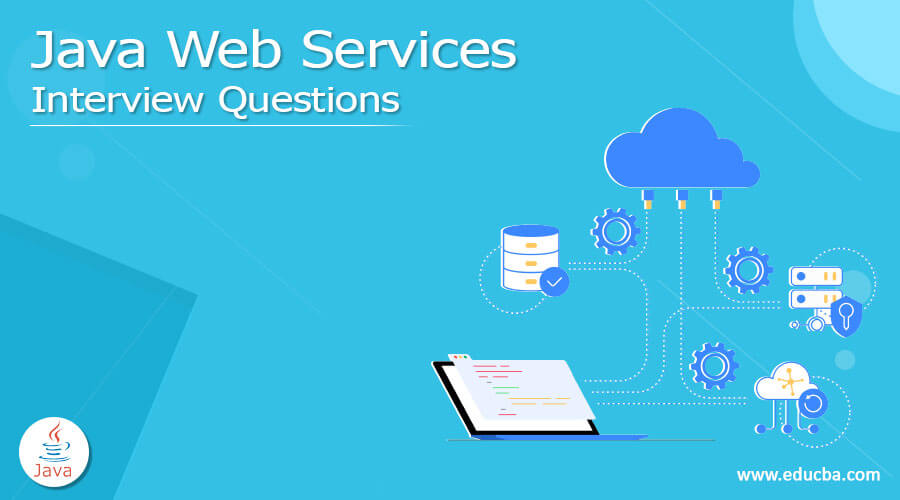Updated June 15, 2023

Introduction to Java Web Services Interview Questions
Java Web service is a method of communication between two devices or Web services: the client and server applications that communicate over the World Wide Web. Java web service includes architecture, components like SOAP (Simple Object Access Protocol), WSDL (Web Services Description Language), Web services security and RESTful web services, etc.
So if you are looking for a job related to Java web services, you must prepare for the Java Web Services Interview Questions. Though every Java Web services interview is different and the job scope is also different, we can help you with the top 2023 Java Web services Interview Questions and Answers, which will help you take the leap and get success in interviews. These questions are divided into two parts as follows:
Part 1 – Java web services Interview Questions (Basic)
This first part covers basic interview questions and answers
1. Mention the main features of web services.
Answer:
Below is the list of features:
- It is available over the Internet or private (intranet) networks.
- It is used as a standardized XML messaging system.
- It is not tied to any one operating system or programming language.
- Supports Document Exchange.
- Synchronous or Asynchronous functionality
- Ability to support Remote Procedure Calls (RPCs)
2. What are the types of Web Services?
Answer:
There are mainly 2 types of Web Services available.
- SOAP web services.
- RESTful web services.
3. What are the components of web service?
Answer:
Web services components are:
- SOAP- Simple Object Access Protocol
- UDDI- Universal Description, Discovery, and Integration
- WSDL- Web Service Description Language
- RDF- Resource Description Framework
- XML- Extensible Markup Language
Let us move on to the following Java web services interview questions.
4. What is XML-RPC? What are the features of XML-RPC?
Answer:
XML-RPC is nothing but an XML-based protocol. It is a straightforward protocol to exchange information between two devices over a network. Dave Winer created the XML-RPC protocol in 1998.
- XML Response is embedded in HTTP response.
- XML is considered Platform independent.
- XML helps in communicating between two different applications.
- XML-RPC uses HTTP protocol to send information between client and server devices
- RPCs are performed using simple XML language.
5. Explain Java API for XML Messaging (JAXM).
Answer:
- JAXM is a SOAP 1.1-based standard to send XML documents over the Internet from the Java platform.
- JAXM can be extended to work with higher-level messaging protocols by adding the protocol’s functionality to the SOAP.
Part 2 – Java web services Interview Questions (Advanced)
Let us now have a look at the advanced Interview Questions.
6. What is JAX PACK? Explain?
Answer:
Java API is for XML pack; it integrates all the programming interfaces by SUN for different web services development. JAX Pack is a bundle of JAXB, JAXM, JAX-RPC, and JAXR. Jax pack includes the documentation for support for the SAX and DOM.SOAP, WSDL, XSLT, EBXML, and UDDI standards. Developing Web Services with Java APIs for XML (JAX Pack) provides exhaustive coverage of Sun’s recently released JAX Pack.
7. Explain Web Service Architecture.
Answer:
Every application or framework needs some architecture to ensure the application is working as designed. It is the operations between two applications running on different platforms and frameworks supported by a different web service standard. In this architecture, we can see three different roles.
- Provider
- Requester
- Broker
Provider: The provider will create the web service and ensure it’s always available to the client application whenever a client wants to use it.
Requester: Requester is the client application; it needs to contact a web service.
Broker: Broker is the application it provides access to the UDDI.
Let us move on to the following Java web services interview questions.
8. Can you explain what UDDI, Disco, and WSDL are?
Answer:
UDDI: Universal description discovery and integration. It’s a directory used to publish and discover public web services.
DISCO: Disco is Commonly known as Discovery. Discovery clubs together standard services and exposes a schema document of the web services.
WSDL: Web Service description language.
9. Explain a few tools that help in testing web services.
Answer:
- SoapUI
- REST client
- JMeter
10. What is SOAP, and give a few advantages to it?
Answer:
SOAP: Simple Object Access Protocol. It is an XML-based protocol that helps in accessing Web services.
- WS Security
- Language-Independent
- Platform Independent
Recommended Articles
We hope that this EDUCBA information on “Java Web Services Interview Questions” was beneficial to you. You can view EDUCBA’s recommended articles for more information.

